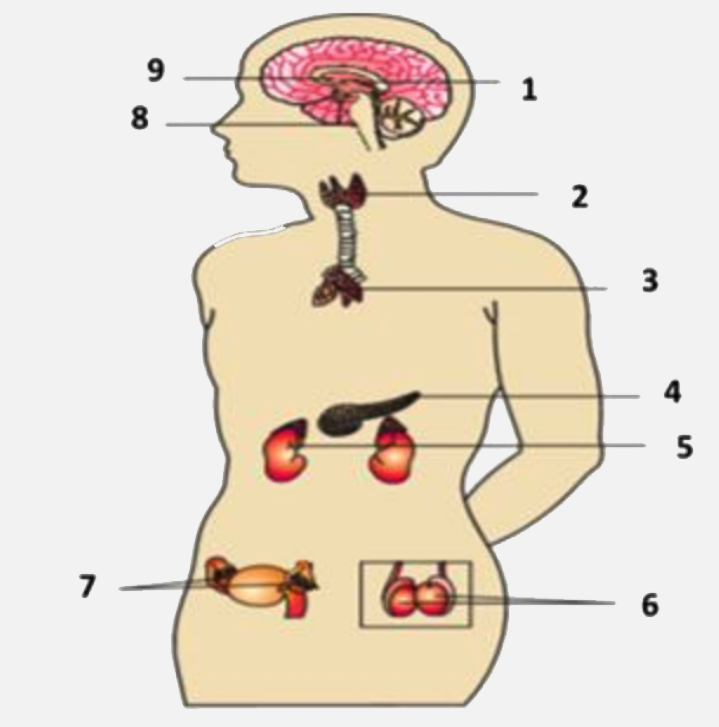ldentify the hormone which performs the following functions -
I. Maintenance of water and electrolyte balance
II. Regulation of BMR
III. Regulation of erythropoiesis
Thyroxine
Adrenaline
ACTH
Estrogen
The correct Answer is:A
To identify the hormone that performs the functions of maintaining water and electrolyte balance, regulating BMR (Basal Metabolic Rate), and regulating erythropoiesis, we can follow these steps:
1. Understanding the Functions:
- Maintenance of Water and Electrolyte Balance: This function is crucial for homeostasis in the body. Hormones involved in this process include aldosterone and antidiuretic hormone (ADH).
- Regulation of BMR: The Basal Metabolic Rate is primarily regulated by thyroid hormones, particularly thyroxine (T4).
- Regulation of Erythropoiesis: Erythropoiesis is the process of red blood cell formation, which is mainly regulated by erythropoietin (EPO), a hormone produced by the kidneys.
2. Identifying the Hormone:
- Since we need a single hormone that covers all three functions, we analyze the roles of the hormones mentioned.
- Thyroxine (T4) is known to regulate metabolism, which indirectly influences water and electrolyte balance, and it also plays a role in erythropoiesis by stimulating the production of red blood cells.
3. Conclusion:
- The hormone that performs the functions of maintaining water and electrolyte balance, regulating BMR, and regulating erythropoiesis is Thyroxine (T4).
Final Answer:
The hormone responsible for all three functions is Thyroxine (T4).
---
- Maintenance of Water and Electrolyte Balance: This function is crucial for homeostasis in the body. Hormones involved in this process include aldosterone and antidiuretic hormone (ADH).
- Regulation of BMR: The Basal Metabolic Rate is primarily regulated by thyroid hormones, particularly thyroxine (T4).
- Regulation of Erythropoiesis: Erythropoiesis is the process of red blood cell formation, which is mainly regulated by erythropoietin (EPO), a hormone produced by the kidneys.
- Since we need a single hormone that covers all three functions, we analyze the roles of the hormones mentioned.
- Thyroxine (T4) is known to regulate metabolism, which indirectly influences water and electrolyte balance, and it also plays a role in erythropoiesis by stimulating the production of red blood cells.
- The hormone that performs the functions of maintaining water and electrolyte balance, regulating BMR, and regulating erythropoiesis is Thyroxine (T4).
The hormone responsible for all three functions is Thyroxine (T4).
Topper's Solved these Questions
Similar Questions
Knowledge Check
The following structures are part of the human brain:- (A) Spinal cord (B) Iter (C) Hypothalamus (D) Cerebral hemispheres (E) Pons (F) Midbrain For each of the following functions of the brain, identify the correct letter of the structure concerned with that function - I. Thermoregulatory centre and regulation of sexual behaviour II. Regulation of optic and auditory reflex III. Centre of thought, memory and speech IV. Pneumotaxic centre V. Neurocoel
AI–D II–F III–C IV–E V–ABI–C II–D III–D IV–E V–BCI–C II–F III–D IV–E V–BDI–C II–F III–D IV–E V–AChoose the statement which correctly indicates the functioning of thyroid hormone
I regulations of the basal metabolic rate.
II support the process of RBC formation
III Regulation the blood calcium levels
IV Maintenance of water and electrolyte balance.
The correct option isAI,II and IVBI and IICI,IIIand IVDIII and IVWhich of the following hormones regulate calcium balance in body ?
ATCTBPTHCADHDBoth A & B
Which of the following sequences is correct for regulation of kidney function?
View SolutionWhich of the organs perform the following function in human ?
(i) Absorption of food
(ii) Absorption of water
View SolutionWhich of the following hormones regulates growth and metamorphosis in insects
View SolutionWhich of the following represents the regulative function of forest?
View SolutionWhich of the following is not ture for the second and regulation of hormone secretion ?
View Solution

